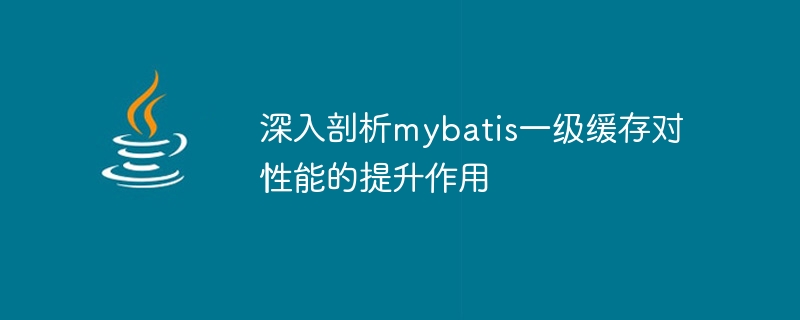Home >Java >javaTutorial >Revealing how mybatis first-level cache optimizes performance
Revealing how mybatis first-level cache optimizes performance
- WBOYWBOYWBOYWBOYWBOYWBOYWBOYWBOYWBOYWBOYWBOYWBOYWBOriginal
- 2024-02-18 12:30:081015browse

In-depth analysis of the performance improvement effect of MyBatis first-level cache
Introduction:
When using MyBatis for data access, we usually hope to improve the performance of the system , reduce the number of database accesses. MyBatis provides a first-level cache function. By caching database query results, repeated database queries can be avoided, thereby improving system performance. This article will deeply analyze the performance improvement effect of MyBatis first-level cache and illustrate it through specific code examples.
1. The working principle of MyBatis's first-level cache
The first-level cache of MyBatis is based on SqlSession. It is enabled by default and is in the open state. When we execute a SQL query, MyBatis will cache the query results into SqlSession and use the query conditions as the cache key. When the same query is executed again, MyBatis will first check whether the corresponding result exists in the first-level cache. If it exists, the result will be obtained directly from the cache without accessing the database.
It should be noted that the life cycle of the first-level cache is consistent with the life cycle of SqlSession. When the SqlSession is closed or committed, the first-level cache will be cleared so that the next query will access the database again.
2. Usage scenarios of MyBatis first-level cache
- Avoid repeated queries: When the same SQL query is executed multiple times, the first-level cache can avoid repeated database access, thereby improving System performance.
- Improve concurrency performance: In a concurrent environment, multiple threads can share the same SqlSession and first-level cache, which can reduce the concurrent access pressure on the database and improve concurrency performance.
3. Code examples
In order to better understand and demonstrate the performance improvement effect of MyBatis first-level cache, we will illustrate it through specific code examples below.
- Create data table and entity class
First, we need to create a data table (an existing table can be used in actual development) and the corresponding entity class.
The SQL statement to create the data table is as follows:
CREATE TABLE user ( id INT(11) PRIMARY KEY AUTO_INCREMENT, name VARCHAR(255) NOT NULL, age INT(11) );
Create the User entity class as follows:
public class User {
private Integer id;
private String name;
private Integer age;
// 省略getter和setter方法
}- Create the Mapper interface and configuration file
Connect Next, we need to create a Mapper interface and corresponding XML configuration file to perform database access operations.
Create the Mapper interface as follows:
public interface UserMapper {
User getUserById(Integer id);
}Create the XML configuration file (UserMapper.xml) as follows:
<mapper namespace="com.example.dao.UserMapper">
<select id="getUserById" resultType="com.example.entity.User">
SELECT * FROM user WHERE id = #{id}
</select>
</mapper>- Use the first-level cache
In In the code, we can perform query operations through the selectOne method of SqlSession, and improve system performance through first-level caching.
public class Main {
public static void main(String[] args) {
// 创建SqlSessionFactory
SqlSessionFactory sessionFactory = new SqlSessionFactoryBuilder().build(Resources.getResourceAsStream("mybatis-config.xml"));
// 创建SqlSession
SqlSession sqlSession = sessionFactory.openSession();
try {
// 获取Mapper对象
UserMapper userMapper = sqlSession.getMapper(UserMapper.class);
// 第一次查询
User user1 = userMapper.getUserById(1);
System.out.println(user1);
// 第二次查询(相同的查询条件)
User user2 = userMapper.getUserById(1);
System.out.println(user2);
} finally {
// 关闭SqlSession
sqlSession.close();
}
}
}In the above sample code, we first execute the getUserById method to obtain user information and save the result to the first-level cache. We then execute the same query again, this time fetching the results directly from the first-level cache without hitting the database again.
By using the first-level cache, we can effectively reduce the number of database accesses and improve system performance.
Summary:
Through an in-depth analysis of the performance improvement effect of MyBatis first-level cache, we understand the working principle and usage scenarios of first-level cache. The first-level cache can avoid repeated database queries, improve system performance, and reduce concurrent access pressure on the database in a concurrent environment. In actual development, we can reasonably use the first-level cache function according to specific business scenarios and performance requirements to achieve optimal performance.
The above is the detailed content of Revealing how mybatis first-level cache optimizes performance. For more information, please follow other related articles on the PHP Chinese website!

